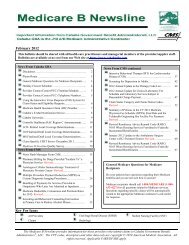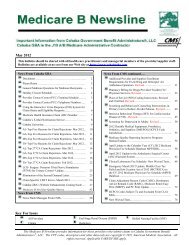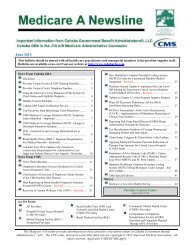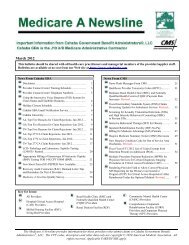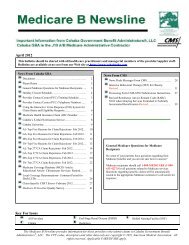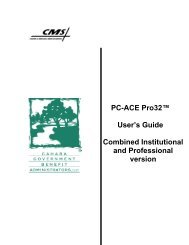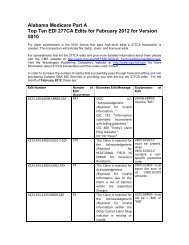Medicare Part B Newsline March 2012 - Cahaba GBA
Medicare Part B Newsline March 2012 - Cahaba GBA
Medicare Part B Newsline March 2012 - Cahaba GBA
- No tags were found...
You also want an ePaper? Increase the reach of your titles
YUMPU automatically turns print PDFs into web optimized ePapers that Google loves.
counseling is furnished by a qualified primary care physician or other primary care practitioner in a primarycare setting are eligible for:One face-to-face visit every week for the first month;One face-to-face visit every other week for months 2-6; andOne face-to-face visit every month for months 7-12, if the beneficiary meets the 3kg (6.6 lbs) weightloss requirement during the first 6 months as discussed below.At the 6-month visit, a reassessment of obesity and a determination of the amount of weight loss should beperformed. To be eligible for additional face-to-face visits occurring once a month for months 7-12,beneficiaries must have achieved a reduction in weight of at least 3kg (6.6 lbs.), over the course of the first 6months of intensive therapy. This determination must be documented in the physician office records forapplicable beneficiaries consistent with usual practice. For beneficiaries who do not achieve a weightloss of at least 3kg (6.6 lbs.) during the first 6 months of intensive therapy, a reassessment of their readinessto change and BMI is appropriate after an additional 6-month period.IBT for obesity consists of the following:1. Screening for obesity in adults using measurement of BMI calculated by dividing weight inkilograms by the square of height in meters (expressed kg/m2);2. Dietary (nutritional) assessment; and,3. Intensive behavioral counseling and behavioral therapy to promote sustained weight loss throughhigh intensity interventions on diet and exercise.Intensive behavioral intervention for obesity should be consistent with the 5-A framework:1. Assess: Ask about/assess behavioral health risk(s) and factors affecting choice of behavior changegoals/methods.2. Advise: Give clear, specific, and personalized behavior change advice, including information aboutpersonal health harms and benefits.3. Agree: Collaboratively select appropriate treatment goals and methods based on the patient’sinterest in and willingness to change the behavior.4. Assist: Using behavior change techniques (self-help and/or counseling), aid the patient in achievingagreed-upon goals by acquiring the skills, confidence, and social/environmental supports forbehavior change, supplemented with adjunctive medical treatments when appropriate.5. Arrange: Schedule follow-up contacts (in person or by telephone) to provide ongoingassistance/support and to adjust the treatment plan as needed, including referral to more intensive orspecialized treatment.<strong>Medicare</strong> B <strong>Newsline</strong> <strong>March</strong> <strong>2012</strong> 48



